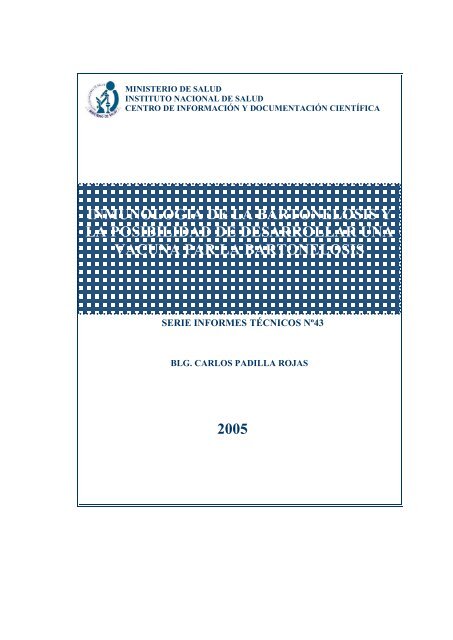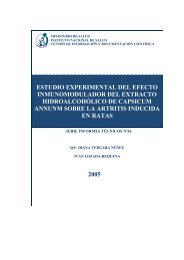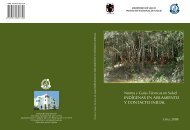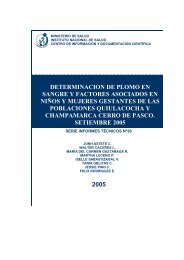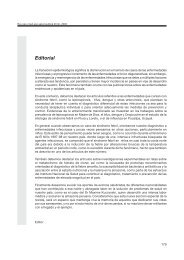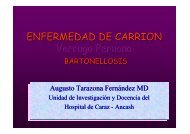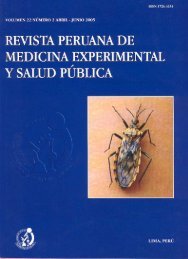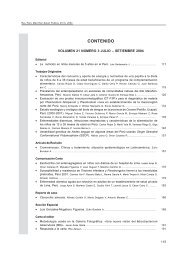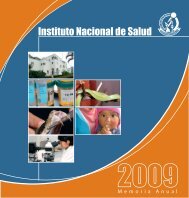INMUNOLOGIA DE LA BARTONELOSIS Y LA ... - BVS - INS
INMUNOLOGIA DE LA BARTONELOSIS Y LA ... - BVS - INS
INMUNOLOGIA DE LA BARTONELOSIS Y LA ... - BVS - INS
You also want an ePaper? Increase the reach of your titles
YUMPU automatically turns print PDFs into web optimized ePapers that Google loves.
MINISTERIO <strong>DE</strong> SALUD<strong>INS</strong>TITUTO NACIONAL <strong>DE</strong> SALUDCENTRO <strong>DE</strong> INFORMACIÓN Y DOCUMENTACIÓN CIENTÍFICA<strong>INMUNOLOGIA</strong> <strong>DE</strong> <strong>LA</strong> <strong>BARTONELOSIS</strong> Y<strong>LA</strong> POSIBILIDAD <strong>DE</strong> <strong>DE</strong>SARROL<strong>LA</strong>R UNAVACUNA PAR <strong>LA</strong> <strong>BARTONELOSIS</strong>SERIE INFORMES TÉCNICOS Nº43BLG. CARLOS PADIL<strong>LA</strong> ROJAS2005
<strong>INMUNOLOGIA</strong> <strong>DE</strong> <strong>LA</strong> <strong>BARTONELOSIS</strong> Y <strong>LA</strong> POSIBILIDAD <strong>DE</strong> <strong>DE</strong>SARROL<strong>LA</strong>R UNA VACUNA PAR <strong>LA</strong><strong>BARTONELOSIS</strong>CÓDIGO OGITT: 2-01-05-03-064ARTICULO <strong>DE</strong> REVISIÓN<strong>INMUNOLOGIA</strong> <strong>DE</strong> <strong>LA</strong> <strong>BARTONELOSIS</strong> Y <strong>LA</strong> POSIBILIDAD <strong>DE</strong><strong>DE</strong>SARROL<strong>LA</strong>R UNA VACUNA PAR <strong>LA</strong> <strong>BARTONELOSIS</strong>Blg. Carlos Padilla RojasLaboratorio de Biotecnología y Biología MolecularCentro Nacional de Salud Publicacpadilla@ins.gob.peINTRODUCCIONLa bartonelosis es un problema de salud importante en nuestro país. Esta enfermedad seconsiderada como re-emergente en el Perú y emergente en el mundo. Actualmente, noexiste una vacuna disponible para la bartonelosis, el control de esta enfermedad se basaen el diagnostico oportuno, el tratamiento eficaz y el control vectorial. Sin embargo, losmétodos de diagnóstico de laboratorio para la bartonelosis actualmente existentespresentan una serie de inconvenientes y el control vectorial es difícil.La observación de casos de bartonelosis que han curado sin tratamiento permite sugerirque el desarrollo de una vacuna para la bartonelosis es posible. Existen 2 tipos deinmunidad que podrían ser efectivas para la protección contra la bartonelosis: lageneración de anticuerpos neutralizantes contra la infección primaria y la activación deuna respuesta celular citotóxica para eliminar células infectadas.Las proteínas de membrana externa han demostrado ser buenas candidatas a vacunas enotros patógenos. En diversas enfermedades bacterianas, la inmunización con estasproteínas (OMPs) dan una adecuada respuesta protectiva, lo que sugiere que tambiénpueda usarse como blanco contra la infección primaría de B. bacilliformis.Por otro lado, la inmunización con proteínas de estrés térmico han demostrado en otrosmodelos ser capaces de activar una respuesta citotóxica.Asi estos antígenos, podrían ser buenos candidatos para vacunas para la bartonelosis.
<strong>INMUNOLOGIA</strong> <strong>DE</strong> <strong>LA</strong> <strong>BARTONELOSIS</strong> Y <strong>LA</strong> POSIBILIDAD <strong>DE</strong> <strong>DE</strong>SARROL<strong>LA</strong>R UNA VACUNA PAR <strong>LA</strong><strong>BARTONELOSIS</strong>TEXTO <strong>DE</strong> <strong>LA</strong> REVISIONLa bartonelosis es una enfermedad re-emergente en nuestro país. Los casos se presentandistribuidos en los valles interandinos comprendidos entre 500 a 3200 m.s.n.m. afectaprincipalmente los departamentos de Ancash, Jaén, Cajamarca, Lima, Amazonas y LaLibertad; y en menor incidencia la sierra de Cuzco, Huancavelica, Huánuco, Piura yAyacucho (OGE, 2006).Esta enfermedad es bifásica, la primera fase esta caracterizada por anemia hemolítica, yfiebre pudiendo llegar a producir la muerte; y la segunda fase es mas benigna y estacaracterizada por erupciones cutáneas verrucosas sangrantes autolimitantes.Actualmente, no existe vacuna para la bartonelosis, el control de bartonelosis se basa encontrol vectorial, el diagnóstico precoz y la medicación oportuna.Sin embargo, el control de las enfermedades metaxénicas mediante control vectorial ademostrado ser difícil debido a que se desconoce los factores que promueven laproliferación de mosquitos vectores; a que la distribución geográfica de estos vectoresno esta lo suficientemente estudiada y varia en el tiempo; y a lo costoso de implementarun sistema de fumigación efectivo y eficaz. Esto es agravado por la posibilidad (yademostrada) de la resistencia de los vectores a los insecticidas.En cuanto al diagnóstico de esta enfermedad, el método mas económico y sencillo es elfrotis sanguíneo, lamentablemente este método diagnóstico presenta muy bajasensibilidad (alrededor del 30%). Entre otros métodos de diagnóstico se encuentra elcultivo el cual demora de 3 a 5 semanas, los métodos serológicos como el ELISA,Western blot e IFI que presentan reacciones cruzadas con otras infecciones y otrosmétodos mas especializados como el PCR solo sirven a nivel referencial.Estos problemas en el diagnóstico acarrean una detección subóptima de pacientes conbartonelosis aguda o crónica, generando demora en le tratamiento de casos agudos(incrementando el riesgo de mortalidad) e incrementando la tasa de transmisión de laesta enfermedad.No existen hasta la fecha información acerca de posibles vacunas para la bartonelosis,sin embargo, diversos hallazgos indican que el diseño de una vacuna es posible.El diseño de una vacuna para la bartonelosis es de suma importancia, ya la vacunaciónpermitiría disminuir la morbilidad y la mortalidad de esta enfermedad. Sin embargo, laidentificación de proteínas que sean buenas candidatas a vacuna no es algo sencillo,
<strong>INMUNOLOGIA</strong> <strong>DE</strong> <strong>LA</strong> <strong>BARTONELOSIS</strong> Y <strong>LA</strong> POSIBILIDAD <strong>DE</strong> <strong>DE</strong>SARROL<strong>LA</strong>R UNA VACUNA PAR <strong>LA</strong><strong>BARTONELOSIS</strong>requiere de una selección y evaluación de la capacidad de estimular el sistema inmunede manera protectiva de muchas candidatas.Las proteínas de membrana externa (OMPs) de muchos patógenos son consideradasbuenas candidatas a vacunas. La inmunización con estas proteínas podría ser protectivasy anticuerpos contra estas bloquearían la infección en modelos experimentales.Por ejemplo, la proteína de membrana externa Omp31 de Brucella ovis es un antígenoinmunodominante, en el modelo murino confiere una importante protección contra labrucelosis (Cloeckaert A y colab, 2002). Las proteínas de membrana externa sonantígenos importantes de B. ovis, anticuerpos monoclonales contra OMP16, OMP19 yOMP31 otorgan alta protección y previenen la esplenomegalia en modelo murino(Bowden R y colab, 2000).Para Chlamydia trachomatis se ha reportado que la proteína de membrana externaMOMP purificada puede generar protección en el modelo murino y protege contrainfección vaginal (Pal S y colab, 2001; Stagg A y colab, 1998).También se ha demostrado que OMP purificadas de Neisseria lactamica protegencontra la infección de Neisseria spp serogrupo B y C aisladas de cuadros de meningitis(Oliver K y colab, 2002). Otros estudios en vacunas basadas en OMPs para Neisseriameningitides del grupo B han demostrado ser eficaces en inducir respuesta protectivabasada en anticuerpos en voluntarios adultos sanos en Cuba, Brasil, Chile y Europa, conuna eficacia entre el 50 al 80% (Bjune y colab, 1991; De Moraes J y colab, 1992; SierraG y colab, 1991; Boslego J y colab, 1995).Se ha reportado que B. bacilliformis presenta al menos 14 proteínas de membranaexterna, las cuales presentan un peso molecular entre 11 a 75 KDa. De estas proteínasde membrana externa, las que presentan 31 (OMP31), 42 (OMP42) y 45 (OMP45) KDason las más antigénicas (Minnick M, 1994).Por otro lado, las proteínas de estrés térmico son buenos candidatos a vacuna en otrospatógenos como Chlamydia pneumoniae en modelo murino (Saren A, 2002),Mycobacterium tuberculosis (Mustafa A, 2002), Brucella (Bae J y colab, 2002).Además, se detectado anticuerpos anti proteínas de estrés térmico en pacientesinfectados con Leptospira (Guerreiro H y colab, 2001).La proteína de estrés térmico (Bb65) ha sido reportado en Bartonella bacilliformiscomo un importante antígeno (Knobloch J y Schreiber M, 1990).Asimismo, ya que B. bacilliformis es un patógeno intracelular facultativo es necesarioevaluar la importancia de una respuesta citotóxica para la resolución de la infección.
<strong>INMUNOLOGIA</strong> <strong>DE</strong> <strong>LA</strong> <strong>BARTONELOSIS</strong> Y <strong>LA</strong> POSIBILIDAD <strong>DE</strong> <strong>DE</strong>SARROL<strong>LA</strong>R UNA VACUNA PAR <strong>LA</strong><strong>BARTONELOSIS</strong>Asi, se ha demostrado que el virus vaccinia es un excelente vector de inmunización, elcual induce preferentemente una respuesta citóxica vía linfocitos T tipo CD8+ (BenninkJR y Yewdell, 1990). Asimismo, el uso de el virus vaccinia como vector ya ha sidoevaluado de manera exitosa para el desarrollo de candidatos a vacuna para latuberculosis (Feng C y colab., 2001), virus de inmunodeficiencia adquirida (Graham By colab., 1994; Glibert P y colab., 2003), leishmaniasis (McMahon-Pratt D y colab.,1993) y listeriosis (An LL y colab., 1996). Además, en algunos casos algunas vacunasbasadas en humanos ya esta en fase 1 demostrando seguridad (Rochlitz C y colab.,2003; Glibert P y colab., 2003).El desarrollo de una vacuna para la bartonelosis requiere de financiamiento, en principiose podría evaluar específicamente antígenos que han funcionado en otros modelos comolas proteínas OMP31, OMP42, OMP45, asimismo otra buena candidata sería Bb65, ialBy FTZ de B. bacilliformis, las cuales podrian ser evaluadas como proteínasrecombinantes y demostrar en principio que son capaces de activar una respuestainmunológica protectiva in vivo en modelo murino y en cultivo in vitro de célulasmononucleares humanas. Si estas candidatas no dan resultados satisfactorios se podríaempezar evaluar la posibilidad de emplear una estrategia masiva, hay reportadas varias,para poder seleccionar un candidato adecuado. Con una buen antígeno candidato sepodría evaluar de manera experimental con primates no humanos en un pequeño piloto(entre 5 a 10 primates no humanos) y si se ven resultados exitosos se podría plantear suevaluación en seres humanos.REFERENCIAS BIBLIOGRAFICASAn LL, Pamer E, Whitton JL. A recombinant minigene vaccine containing anonameric cytotoxic-T-lymphocyte epitope confers limited protection against Listeriamonocytogenes infection. Infect Immun 1996; 64(5):1685-1693.Anderson BE, Neuman MA. Bartonella sp. as emerging human pathogens. ClinicalMicrobiological Reviews 1997; 10(2): pp 203-219.Bae JE, Schurig GG, Toth TE. Mice immune responses to Brucella abortus heatshock proteins. Use of baculovirus recombinant-expressing whole insect cells, purifiedBrucella abortus recombinant proteins, and a vaccinia virus recombinant asimmunogens. Vet Microbiol 2002; 88(2):189-202.
<strong>INMUNOLOGIA</strong> <strong>DE</strong> <strong>LA</strong> <strong>BARTONELOSIS</strong> Y <strong>LA</strong> POSIBILIDAD <strong>DE</strong> <strong>DE</strong>SARROL<strong>LA</strong>R UNA VACUNA PAR <strong>LA</strong><strong>BARTONELOSIS</strong>Bakke H, Lie K, Haugen IL, Korsvold GE, Hoiby EA, Naess LM, Holst J, AabergeIS, Oftung F, Haneberg B. Meningococcal outer membrane vesicle vaccine givenintranasally can induce immunological memory and booster responses without evidenceof tolerance. Infect Immun 2001; 69(8):5010-5.Bennink JR, Yewdell JW. Recombinant vaccinia viruses as vectors for studying Tlymphocyte specifity and function. Curr Top Microbiol Immunol 1990; 163: 153-184.Bradford MM. A rapid and sensitive method for the cuantification of microgramquatities of protein utilizing the principle of protein-dye binding. Ann. Biochem 1976;72:248-254.Bjune G, Hoiby EA, Gronnesby JK, Arnesen O, Fredriksen HH, Halstensen A, etal. Effect of outer membrane vesicle vaccine against group B meningococcal disease inNorway. Lancet 1991; 338:1093-1096Boslego J, Garcia J, Cruz C, Zollinger WD, Brandt B, Ruiz S, et al. Efficacy, safetyand immunogenicity of a meningococcal group B (15:P1.3) outer membrane proteinvaccine in Iquique, Chile. Vaccine 1995; 13:821-829.[Bowden RA, Estein SM, Zygmunt MS, Dubray G, Cloeckaert A. Identification ofprotective outer membrane antigens of Brucella ovis by passive immunization of micewith monoclonal antibodies. Microbes Infect 2000; 2(5):481-8.Brennan FR, Jones TD, Gilleland LB, Bellaby T, Xu F, North PC, Thompson A,Staczek J, Lin T, Johnson JE, Hamilton WD, Gilleland HE Jr. Pseudomonasaeruginosa outer-membrane protein F epitopes are highly immunogenic in mice whenexpressed on a plant virus. Microbiol 1999;145 ( Pt 1):211-20.Chamberlin J, Laughlin L, Gordon S, Romero S, Solorzano N, Regnery RL.Serodiagnosis of Bartonella bacilliformis infection by indirect fluorescence antibodyassay: test development and application to a population in an area of bartonellosisendemicity. J Clin Microbiol 2000; 38(11):4269-71.Cloeckaert A, Vizcaino N, Paquet JY, Bowden RA, Elzer PH. Major outermembrane proteins of Brucella spp.: past, present and future. Vet Microbiol 2002; 90(1-4):229-47.De Moraes JC, Perkins BA, Camargo MC, Hidalgo NT, Barbosa HA, Sacchi CT,et al. 1992. Protective efficacy of a serogroup B meningococcal vaccine in Sao Paulo,Brazil. Lancet 1992; 340:1074-1078.[Ellis BA, Rotz L D, Leake J A D, Samalvides F, Bernable J, Ventura G, Padilla C,Villaseca P, Beati L, Regnery R, Childs JE, Olson JG, Carillo CP. An outbreak of
<strong>INMUNOLOGIA</strong> <strong>DE</strong> <strong>LA</strong> <strong>BARTONELOSIS</strong> Y <strong>LA</strong> POSIBILIDAD <strong>DE</strong> <strong>DE</strong>SARROL<strong>LA</strong>R UNA VACUNA PAR <strong>LA</strong><strong>BARTONELOSIS</strong>acute Bartonellosis (Oroya Fever) in Urubamba region of Peru, 1998. Am J Trop MedHyg 1999; 61 (2): 344-349.Feng CG, Blanchard TJ, Smith GL, Hill AV, Britton WJ. Induction of CD8+ T-lymphocyte responses to a secreted antigen of Mycobacterium tuberculosis by anattenuated vaccinia virus. Immunol Cell Biol 2001; 79(6):569-75.Fuhrmann O, Arvand M, Gohler A, Schmid M, Krull M, Hippenstiel S, Seybold J,Dehio C, Suttorp N. Bartonella henselae induces NF-kappaB-dependent upregulationof adhesion molecules in cultured human endothelial cells: possible role of outermembrane proteins as pathogenic factors. Infect Immun 2001; 69(8):5088-97.Gilbert PB, Chiu YL, Allen M, Lawrence DN, Chapdu C, Israel H, Holman D,Keefer MC, Wolff M, Frey SE; NIAID HIV Vaccine Trials Network. Long-termsafety analysis of preventive HIV-1 vaccines evaluated in AIDS vaccine evaluationgroup NIAID-sponsored Phase I and II clinical trials. Vaccine 2003; 21(21-22):2933-2947.Graham BS, Gorse GJ, Schwartz DH, Keefer MC, McElrath MJ, Matthews TJ,Wright PF, Belshe RB, Clements ML, Dolin R, et al. Determinants of antibodyresponse after recombinant gp160 boosting in vaccinia-naive volunteers primed withgp160-recombinant vaccinia virus. The National Institute of Allergy and InfectiousDiseases AIDS Vaccine Clinical Trials Network. J Infect Dis 1994; 170(4):782-786.Guerreiro H, Croda J, Flannery B, Mazel M, Matsunaga J, Galvao Reis M, LevettPN, Ko AI, Haake DA. Leptospiral proteins recognized during the humoral immuneresponse to leptospirosis in humans. Infect Immun 2001; 69(8):4958-68.Haake DA, Summers TA, McCoy AM, Scwartzman W. Heat shock response andgroEL sequence of Bartonella hensenlae and Bartonella quintana. Microbiol 1997; 143:2807-2815.Knobloch J, Schreiber M. Bb65 a major immunoreactive protein of Bartonellabacilliformis. Am J Trop Med Hyg 1990; 43:373-379.Koesling J, Aebischer T, Falch C, Schülein R, Dehio C. Cutting edge: Antibodymediatedcessation of hemotropic infection by the intraerythrocytic mouse pathogenBartonella grahamii. J Immunol 2001; 167(1):11-14.Kosoy M, Regnery R, Tzianaos T, Marston E, Jones D, Green D, Maupin G,Olson J, Childs J. Distribution, diversity and host specificity of Bartonella in rodentsfrom the Southeastern United States. Am J Trop Med Hyg 1997; 57(5), 578-588.
<strong>INMUNOLOGIA</strong> <strong>DE</strong> <strong>LA</strong> <strong>BARTONELOSIS</strong> Y <strong>LA</strong> POSIBILIDAD <strong>DE</strong> <strong>DE</strong>SARROL<strong>LA</strong>R UNA VACUNA PAR <strong>LA</strong><strong>BARTONELOSIS</strong>Regnery RL, Anderson BE, Clarridge JE, Rodriguez-Barradas MC, Jones DC,Carr JH. Characterization of novel Rochalimaea species, R henselae sp. nov.,isolated from blood of a febrile, human immunodeficiency virus-positive patient. JClin Microbiol 1992; 30: 265-274.Rochlitz C, Figlin R, Squiban P, Salzberg M, Pless M, Herrmann R, Tartour E,Zhao Y, Bizouarne N, Baudin M, Acres B. Phase I immunotherapy with a modifiedvaccinia virus (MVA) expressing human MUC1 as antigen-specific immunotherapyin patients with MUC1-positive advanced cancer. J Gene Med 2003;5(8):690-699.Saren A, Pascolo S, Stevanovic S, Dumrese T, Puolakkainen M, Sarvas M,Rammensee HG, Vuola JM. Identification of Chlamydia pneumoniae-derived mouseCD8 epitopes. Infect Immun 2002; 70(7):3336-43.Seubert A, Falch C, Birtles R, Schulein R, Dehio C. Characterization of the cripticplasmid pBGR1 from Bartonella grahamii and construction of versatile Escherichiacoli-Bartonella spp. shuttle cloning vector. Plasmid 2003; 49: 44-52.Sambrook J, Fritsch E F, Maniatis T. 1989. Molecular Cloning, A LaboratoryManual. Segunda Edicion. Cold Spring Harbor Laboratory Press.Scherer DC, DeBuron-Connors I, Minnick MF. Characterization of Bartonellabacilliformis flagella and efect of antiflagelina antibodies on invasión of humanerythrocytes. Infect Immun 1993; 61: pp 4962-4971.Sierra GVG, Campa HC, Varcacel NM, Garcia IL, Izquierdo PL, Sotolongo PF,Casanueva GV, Rico CO, Rodríguez CR, Ferry MH. Vaccine against group BNeisseria meningitidis: protection trial and mass vaccination results in Cuba. NIPH Ann1991; 14:195-210.Stagg AJ. Vaccines against Chlamydia: approaches and progress. Mol. Med. Today1998; 4:166-173Urwin R, Holmes EC, Fox AJ, Derrick JP, Maiden MC. Phylogenetic evidence forfrequent positive selection and recombination in the meningococcal surface antigenPorB. Mol Biol Evol 2002; 19(10):1686-94.Wright JC, Williams JN, Christodoulides M, Heckels JE. Immunization with therecombinant PorB outer membrane protein induces a bactericidal immune responseagainst Neisseria meningitidis. Infect Immun 2002; 70(8):4028-34.


